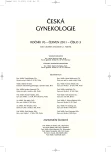The role of hysterectomy in management of cervical precancer lesions
Authors:
J. Sláma
Authors‘ workplace:
Onkogynekologické centrum, Gynekologicko-porodnická klinika VFN a 1. LF UK, Praha, přednosta prof. MUDr. A. Martan, DrSc.
Published in:
Ceska Gynekol 2011; 76(3): 180-183
Overview
Objective:
To conclude conditions, indications and principles of performance of hysterectomy for cervical precancer lesions.
Design:
Review article.
Setting:
Oncogynecological center, Department of Gynecology and Obstetrics, General Faculty Hospital and 1st Medical School of Charles University, Prague.
Methods and results:
Hysterectomy is considered as “gold standard” only in management of glandular precancer lesions. Decision making about hysterectomy in other cases must respect some negative effects of hysterectomy on the one hand and high therapeutical efficacy of conservative surgical procedures and comparable incidence of vaginal and cervical invasive cancers in radically or conservativelly managed women on the other hand.
Conclusions:
Indications for hysterectomy in cervical precancer lesions should be strictly individualised and limited to patients without reproductive desire and to patients in which “occult” invasive cancer is excluded.
Key words:
AIS, CIN, cervical cancer, hysterectomy.
Sources
1. Altman, D., Granath, F., Cnattingius, S., et al. Hysterectomy and risk of stress-urinary-incontinence surgery: nationwide cohort study. Lancet, 2007, 370, p. 1494-1499.
2. Cibula, D., Freitag, P., Mareš, P., et al. Radikální parametrektomie u žen s invazivním karcinomem děložního hrdla po předchozí prosté hysterektomii. Čes Gynek, 2006, 71, 2, s. 122-126.
3. Fischerová, D., Cibula, D., Štěňhová, H., et. al. Využití transrektálního ultrazvukového vyšetření a magnetické rezonance ve stagingu časných stadií zhoubného nádoru děložního hrdla. Čes Gynek, 2009, 74, s. 323-329.
4. Hefler, LA., Polterauer, S., Schneitter, A., et al. Repeat surgery in patients with cervical cancer stage FIGO IA1: a series of 156 cases and a review of the literature. Anticancer Res, 2010, 30, p. 565-568.
5. Chen, Y., Lu, H., Wan, X., et al. Factors associated with positive margins in patients with cervical intraepithelial neoplasia grade 3 and postconization management. Int J Gynaecol Obstet, 2009, 107, p. 107-110.
6. Jordan, J., Martin-Hirsch, P., Arbyn, M., et al. European guidelines for clinical management of abnormal cervical cytology, Part 2. Cytopathology, 2009, 20, p. 5-16.
7. Lu, CH., Liu, FS., Kuo, CJ., et al. Prediction of persistence or recurrence after conization for cervical intraepithelial neoplasia III. Obstet Gynecol, 2006, 107, p. 830-835.
8. Lukanovic, A., Drazic, K. Risk factors for vaginal prolapse after hysterectomy. Int J Gynaecol Obstet, 2010, 110, p. 27-30.
9. Paraskevaidis, E., Arbyn, M., Sotiriadis, A., et al. The role of HPV DNA testing in the follow-up period after treatment for CIN: a systematic review of the literature. Cancer Treat Rev, 2004, 30, p. 205-211.
10. Prendiville, W. Treatment of CIN: what are the risks? Cytopathology, 2009, 20, p. 145-153.
11. Salani, R., Puri, I., Bristow, RE. Adenocarcinoma in situ of the uterine cervix: a metaanalysis of 1278 patients evaluating the predictive value of conization margin status. Am J Obstet Gynecol, 2009, 200, p. 182.e1-182.e5.
12. Schockaert, S., Poppe, W., Arbyn, M., et al. Incidence of vaginal intraepithelial neoplasia after hysterectomy for cervical intraepithelial neoplasia: a retrospective study. Am J Obstet Gynecol, 2008, 199, p. 1-5.
13. Soutter, WP., Sasieni, P., Panoskaltsis, T. Long-term risk of invasive cervical cancer after treatment of squamous cervical intraepithelial neoplasia. Int J Cancer, 2005, 118, p. 2048-2055.
14. Strander, B., Andersson-Ellstrom, A., Milsom, I., et al. Long term risk of invasive cancer after treatment for cervical intraepithelial neoplasia grade 3: population based cohort study. BMJ, 2007, 335, p. 1077-1080.
15. Verguts, J., Bronselaer, B., Donders, G., et al. Prediction of recurrence after treatment for high-grade cervical intraepithelial neoplasia: the role of human papillomavirus testing and age at conisation. BJOG, 2006, 113, p. 1303-1307.
16. Wright, TC. jr., Massad, LS., Dunton, CJ., et al. 2006 consensus guidelines for the management of women with cervical intraepithelial neoplasia or adenocarcinoma in situ. Am J Obstet Gynecol, 2007, 197, p. 340-345.
17. Young, JL., Jazaeri, AA., Lachance JA., et al. Cervical adenocarcinoma in situ: the predictive value of conization margin status. Am J Obstet Gynecol, 2007, 197, p. 195.e1-195.e8.
Labels
Paediatric gynaecology Gynaecology and obstetrics Reproduction medicineArticle was published in
Czech Gynaecology

2011 Issue 3
Most read in this issue
- High resistance of bacterial strains Streptococcus agalactiae to antibiotic therapy in early-onset and late-onset disease in newborns
- Optimization of antibodies examanination against thrombocytes in pregnant and postpartum women
- Biophysical methods in diagnosis of intrapartal fetal hypoxia
- The role of hysterectomy in management of cervical precancer lesions
